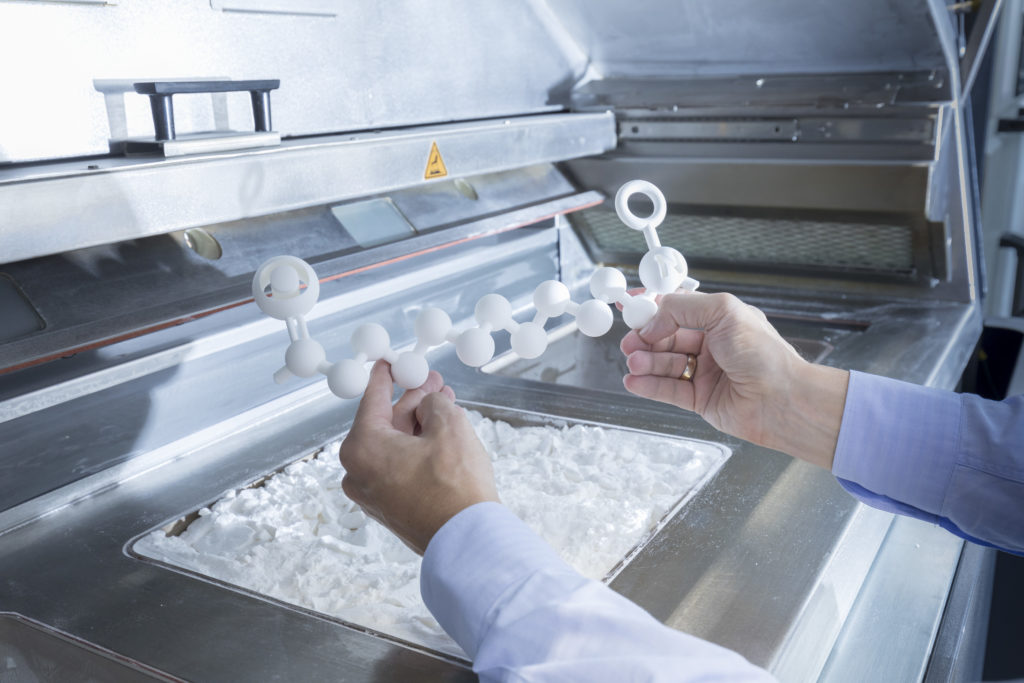For years, Germany’s Evonik has been one of the largest suppliers of materials for additive manufacturing (AM), reigning supreme in polymers for powder bed fusion (PBF). Among them is its polyamide (PA) 12 range, some of the most prevalent materials worldwide. Therefore, it is big news that Evonik’s INFINAM Polyamide 12 powder is now to be made with nearly 50 percent less embodied carbon dioxide (CO2). Moreover, the company highlights the reduced water and land use associated with the material.
Overall, Evonik has looked deep and hard at its own energy use and emissions throughout the value chain and has decided to manufacture its PA12 using renewable energy at Marl Chemical Park in Germany. This is part of a move towards greater sustainability insight and more sustainable materials. What I like most about this is that this will not be offered as a single sustainable powder or as a single material option. No, this will replace all of Evonik´s existing PA 12 materials for PBF, including Multi Jet Fusion and high speed sintering (branded as Selective Absorption Fusion under Stratasys).
Moving to a carbon-reduced powder is much more fundamental than simply having a single feel-good material option that no one buys. To me, this strengthens the idea that the planet is not optional, a luxury premium choice. Instead, the health of our ecosystem should lead to changing business processes to more sustainable practices, permanently. This is also convenient given the pressure on oil and especially gas prices brought about by the Russian invasion of Ukraine. Being able to turn to solar and other energy sources in part insulates them from fossil fuel prices and volatility in fossil fuels.
“Sustainability is the core element for being successful in the future. That’s why we take a holistic view on it at Evonik. Alongside factors such as production efficiency or the reusability of materials, our sustainability approach includes the total life cycle assessments of our materials and their consistent improvement. Using green energy and renewable or recycled feedstocks for production, we are able to significantly improve the overall eco-balance of our materials. And we work on end-of-life opportunities for our polymers,” said Dr. Dominic Störkle, Head of the Additive Manufacturing Innovation Growth Field at Evonik.
The company also looked at the carbon footprint of its Terra product which uses castor oil as a basis for PA. It then compared the footprint in Co2, water and land use of Terra with that of the renewable energy-powered PA. The conclusion was that it was more sustainable. This could be a cute and gossamer-thin veiled reference to Arkema´s castor bean-based PA 11 material line, Rilsan.
There are a few things we can say about such a comparison. Plant-based doesn’t always mean that something is universally good. Additionally, what do companies mean when they use the word “sustainability?” There is no universally available scorecard for “sustainable.” It is very difficult to compare multiple companies’ efforts in this realm. Also, does the lower water use for castor beans really mean that an oil-based material is the better choice? We can’t really compare these apples and oranges well now. However, I love the fact that we’ve begun to hear so many consumer-driven references to castor bean- and plant-based polyamides that Evonik feels the need to compare.
Bring on the sustainability wars! I, for one, hope that it becomes universally clear how sustainable 3D printing really is. I’d love to be able to rank all of the materials according to energy use. I’d love to see polymer companies falling over themselves to showcase who has the most sustainable materials.

